#Zvezda Service Module
Explore tagged Tumblr posts
Text
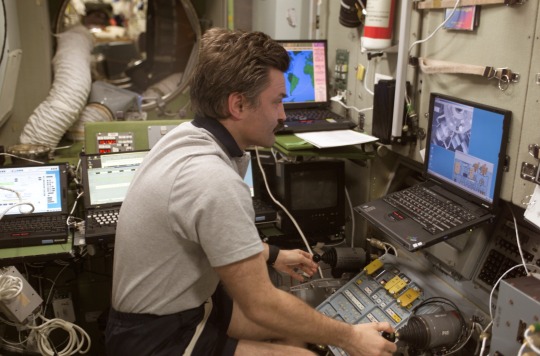
ThinkPad
“TORU docking system used to manually dock Progress freighters to ISS. Cosmonaut Alexander Y. Kaleri, Expedition 8 flight engineer, practices docking procedures with the manual TORU rendezvous system in the Zvezda Service Module on the International Space Station (ISS) in preparation for the docking of the Progress 13 on January 31. With the manual TORU mode, Kaleri can perform necessary guidance functions from Zvezda via two hand controllers in the event of a failure of the ‘Kurs’ automated rendezvous and docking (AR&D;) of the Progress. Kaleri represents Rosaviakosmos.” - via Wikimedia Commons
#thinkpad#lenovo#wikipedia#wikipedia pictures#wikimedia commons#astronaut#international space station#iss#Alexander Y. Kaleri#cosmonaut#Zvezda Service Module#technology#tech#techcore#technologycore#2000s tech#early 2000s#retro tech#2004#outer space#space travel
9 notes
·
View notes
Text





Docking of the Russian Progress 91 cargo ship with the International Space Station's Zvezda service module today, March 1, 2025. Progress cargo ships are unmanned spacecraft that automatically dock to the ISS to supply the station with food, experiments, and other supplies.
51 notes
·
View notes
Text
US space officials do not like to talk about the perils of flying astronauts on the aging International Space Station, elements of which are now more than a quarter of a century old.
However, a new report confirms that NASA managers responsible for operating the space station are seriously concerned about a small Russian part of the station, essentially a tunnel that connects a larger module to a docking port, which is leaking.
Russian and US officials have known that this small PrK module, which lies between a Progress spacecraft airlock and the Zvezda module, has been leaking since September 2019. A new report, published Thursday by NASA's inspector general, provides details not previously released by the space agency that underline the severity of the problem.
New Details About the Leak
For example, in February of this year NASA identified an increase in the leak rate from less than 1 pound of atmosphere a day to 2.4 pounds a day, and in April this rate increased to 3.7 pounds a day. Despite years of investigation, neither Russian nor US officials have identified the underlying cause of the leak.
"Although the root cause of the leak remains unknown, both agencies have narrowed their focus to internal and external welds," the report, signed by Deputy Inspector General George A. Scott, states.
The plan to mitigate the risk is to keep the hatch on the Zvezda module leading to the PrK tunnel closed. Eventually, if the leak worsens further, this hatch might need to be closed permanently, reducing the number of Russian docking ports on the space station from four to three.
Publicly, NASA has sought to minimize concerns about the cracking issue because it remains, to date, confined to the PrK tunnel and has not spread to other parts of the station. Nevertheless, Ars reported in June that the cracking issue has reached the highest level of concern on the space agency's 5x5 "risk matrix" to classify the likelihood and consequence of risks to spaceflight activities. The Russian leaks are now classified as a "5" both in terms of high likelihood and high consequence.
At the time, NASA would not comment on, or confirm, the space agency's concerns about the risk matrix rating. However, the new report confirms the agency's concerns.
"In May and June 2024, ISS Program and Roscosmos officials met to discuss heightened concerns with the increased leak rate," the inspector general's report states. "The ISS Program subsequently elevated the Service Module Transfer Tunnel leak risk to the highest level of risk in its risk management system. According to NASA, Roscosmos is confident they will be able to monitor and close the hatch to the Service Module prior to the leak rate reaching an untenable level. However, NASA and Roscosmos have not reached an agreement on the point at which the leak rate is untenable."
An Uncertain Future in Low Earth Orbit
The report comes as NASA is considering the future of the space station. The US space agency and Russia have an agreement to continue flying the station through 2028, and NASA would like to extend operations to 2030. NASA had anticipated that it would agree to this extension more than a year ago, but as of yet no agreement has been finalized.
Once the station reaches the end of its life, NASA intends to transition its activities in low Earth orbit onto private space stations, and it has funded initial development work by Axiom Space, Northrop Grumman, Blue Origin, and Voyager Space. Northrop has since dropped out of the competition—determining that it would not be a profitable business. There is general uncertainty as to whether any of the private space station operators will be ready in 2030.
NASA's other potential option is extending the life of the space station beyond 2030, but this would require a lot of work to ensure the space station's structure remains viable and yet another extension agreement with Russia. The US partnership with that nation has been severely strained by Russia's invasion of Ukraine.
"Extending the ISS past 2030 will require significant funding to operate and maintain the station, acceptance of increased risk stemming from its components and aging structures, and assurances of continued support from NASA’s international partners," the new report states. “Further complicating matters is the likelihood that NASA may continue to face a flat or reduced budget, inflation, and supply chain challenges.”
14 notes
·
View notes
Text
Launch of STS-92 Discovery






"In a perfect on-time launch at 7:17 p.m. EDT, Space Shuttle Discovery trails a blaze of flame amid clouds of smoke and steam as it leaps into the night sky. The launch of mission STS-92 carries a crew of seven on a construction flight to the International Space Station. Discovery also carries a payload that includes the Integrated Truss Structure Z-1, first of 10 trusses that will form the backbone of the Space Station, and the third Pressurized Mating Adapter that will provide a Shuttle docking port for solar array installation on the sixth Station flight and Lab installation on the seventh Station flight. Discovery’s landing is expected Oct. 22 at 2:10 p.m. EDT"
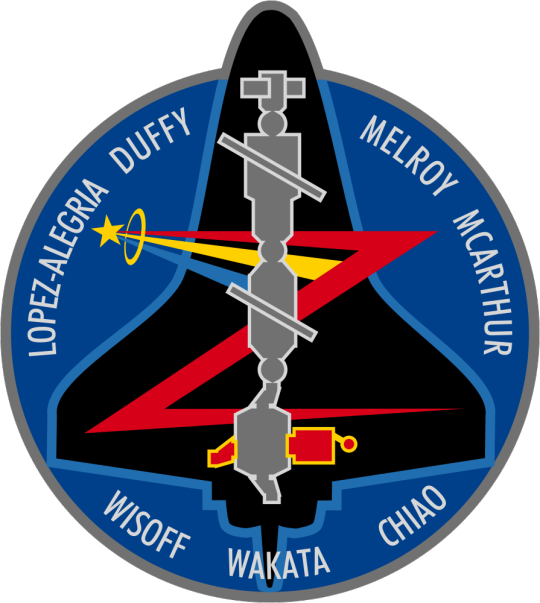
"Designed by the crew members, the STS-92 patch symbolizes the second mission to carry U.S.-built elements to the International Space Station (ISS) for assembly. The black silhouette of the Space Shuttle Discovery stands out against the deep blue background of space in low Earth orbit. In the foreground in gray is a profile view of the ISS as it appears when the shuttle and crew arrive, with the station consisting of the Unity node, its two pressurized mating adapters (PMA), the Zarya functional cargo block, the Zvezda service module, and the Progress cargo vehicle.
Following the shuttle's rendezvous and docking, the ISS configuration will be augmented by the two elements delivered by Discovery–the Z1 truss and PMA-3. These two elements, depicted in red, will be installed using the shuttle's robot arm and be connected to ISS during four spacewalks. The multi-national nature of both the STS-92 crew and the ISS are reflected in the multi-colored Astronaut Office symbol."
Date: October 11, 2000
NASA ID: KSC-00PP-1551, KSC00pd1549, KSC-00PP-1552, KSC-00PP-1561, KSC-00PP-1557, KSC-00PP-1555, STS092-S-001
#STS-92#Space Shuttle#Space Shuttle Discovery#Discovery#OV-103#Orbiter#NASA#Space Shuttle Program#launch#LC-39A#Kennedy Space Center#Florida#October#2000#my post
70 notes
·
View notes
Link
This is already the 348th correction of the ISS orbital altitude in the history of the station’s flight. This morning, October 19, 2023, the orbit of the International Space Station was adjusted to create the necessary ballistic conditions for the launch of the Progress MS-25 cargo ship. The press service of Roscosmos spoke about this. [caption id="attachment_71697" align="aligncenter" width="780"] MS-25 spacecraft[/caption] The engines of the Progress MS-24 cargo ship docked to the Zvezda service module of the Russian segment of the ISS, were turned on at 06:46 Moscow time and worked for 1029.9 seconds, producing an impulse of 1.5 m/s. After the maneuver, the average altitude of the ISS orbit increased by 2.8 km and amounted to 418.23 km above the Earth’s surface. ISS is being prepared for the launch of the Progress MS-25 spacecraft During the entire flight of the ISS, 348 corrections to the altitude of its orbit were carried out, 194 of them using the engines of the Progress spacecraft. The launch of the Progress MS-25 cargo ship from the Baikonur Cosmodrome using the Soyuz-2.1a launch vehicle is scheduled for December 1, 2023. Currently on board, the ISS is the crew of the 70th long-term expedition, which includes cosmonauts Oleg Kononenko, Nikolai Chub, and Konstantin Borisov, NASA astronauts Jasmine Moghbeli and Loral O'Hara, ESA astronaut Andreas Mogensen and JAXA astronaut Satoshi Furukawa.
#cosmonauts#Crewed_Mission#International_Space_Station_ISS#ISS_crew#mission_details#MS_25_spacecraft#Russian_spacecraft#space_exploration#space_mission#space_research#space_science#space_station#space_technology#space_travel#Spacecraft_Launch
2 notes
·
View notes
Text
NASA Postpones Axiom Mission 4 Launch to Ensure Space Station Readiness After Repairs
NASA has postponed the launch to the International Space Station of an Axiom Space commercial crew mission, Axiom Mission 4 (Ax-4), that was planned to launch on or after June 22 to allow more time to ***ess the readiness of the station’s configuration. The station is undergoing inspections following recent repair operations on the end of the Zvezda service module. Because the station’s life…
0 notes
Text
NASA, Axiom Space Delay Axiom Mission 4 Launch to Space Station - NASA
0 notes
Text
Axiom-4 launch with India's Shubhanshu Shukla delayed over ISS leak
Axiom Mission 4, carrying Indian astronaut Shubhanshu Shukla, has been delayed as Nasa and Roscosmos investigate a pressure anomaly in the ISS’s Zvezda service module
0 notes
Text
Space habitat reports – Mar.10.2025
Here is a new selection of videos, articles, and news items about space habitats (govt and commercial), living in space, and space settlement. === International Space Station & NASA ** Space to Ground: On the Station, On the Moon: March 07, 2025 - NASA Johnson NASA's Space to Ground is your weekly update on what's happening aboard the International Space Station. ** Space to Ground: The Power of 10: Feb. 28, 2025 - NASA Johnson ** Space to Ground: Hailing Frequencies: Feb. 07, 2025 - NASA Johnson ** NASA’s SpaceX Crew-9 Pre-Departure News Conference – Tuesday, March 4, 2025 - NASA Video Aboard the International Space Station NASA astronauts Nick Hague, Suni Williams, and Butch Wilmore gave remarks about their mission during a news conference March 4. The Crew-9 astronauts will return to Earth via a parachute assisted splashdown later this month. The four crew members have been living and working aboard the microgravity laboratory to advance scientific knowledge and demonstrate new technologies for future human and robotic exploration flights as part of NASA’s Moon and Mars exploration approach, including lunar missions through NASA’s Artemis program. ** Progress MS-30 docking - SciNews The Progress MS-30 spacecraft autonomously docked to the aft port of the Zvezda service module, on the International Space Station, on 1 March 2025, at 23:02 UTC (18:02 EST). Progress MS-30 (ISS Progress 91 mission) delivers approximately three tons of food, fuel, and supplies for the crew aboard the International Space Station. Credit: NASA/Roscosmos Music: “Waltz of the Flowers by Tchaikovsky” courtesy of YouTube Audio Library ** What if the ISS was retired early? - Laura Forczyk Elon Musk is calling for the International Space Station to be deorbited earlier than the currently planned 2030, even as early as 2027. How would that work with SpaceX's US Deorbit Vehicle and NASA's international partners? What would happen with the ongoing microgravity research? None of the commercial space stations will be ready in time for long-term habitation, and alternatives ideas such as using Starship as a space station aren't guaranteed to happen in time, either. How much would China benefit from having the Tiangong, the only low-Earth orbit destination? Congress is going to push back on any proposal by the Trump Administration to "abandon LEO" in favor of sending astronauts to Mars, but how this plays out is to be seen. ** Visualizing the scale of the ISS: Another time-honored Super Bowl tradition: Did you know that the @Space_Station is 357 feet end-to-end? That’s almost the same length as a football field, including both end zones. #SBLIX pic.twitter.com/UsqPaDuG7o — NASA (@NASA) February 9, 2025 ** ISS crewmember Matthew Dominick, with the assistance of Don Pettit, demonstrates the basics of propellant transfer in micro-gravity and have fun doing it: Don (@astro_Pettit) and I decided to demo how spaceships could transfer rocket fuel (AKA propellant) in space using water bottles, water, and Alka-Seltzer . . . what could go wrong? pic.twitter.com/BJdmKPtIRr — Matthew Dominick (@dominickmatthew) February 12, 2025 ** NASA Astronaut Suni Williams Talks with the U.S. Naval Academy Alumni Association- February 25, 2025 - NASA Video Aboard the International Space Station, Expedition 72 commander Suni Williams of NASA discussed life and work aboard the orbital outpost during an in-flight interview Feb. 25 with the U.S. Naval Academy Alumni Association. Williams, a graduate of the academy, is in the midst of a long-duration mission living and working aboard the microgravity laboratory to advance scientific knowledge and demonstrate new technologies for future human and robotic exploration flights as part of NASA’s Moon and Mars exploration approach, including lunar missions through NASA’s Artemis program. === Commercial space habitats ** Axiom Space --- Axiom and Red Hat to demonstrate orbital data center on the ISS in 2025: Red Hat Teams Up with Axiom Space to Launch, Optimize the Space Company’s Data Center Unit-1 On Orbit | Red Hat - Mar.6.2025 Red Hat, Inc., the world's leading provider of open source solutions and Axiom Space, leading provider of in-space infrastructure, will collaborate on Axiom Space’s Data Center Unit-1 (AxDCU-1), targeted to launch in spring 2025 to the International Space Station. Powered by Red Hat Device Edge, the data processing prototype will conduct tests on the space station and demonstrate initial Orbital Data Center (ODC) capabilities. The prototype will test applications in cloud computing, artificial intelligence and machine learning (AI/ML), data fusion and space cybersecurity. AxDCU-1 is part of Axiom Space’s ongoing work to develop era-defining space infrastructure. Red Hat Device Edge combines an enterprise-ready and supported distribution of the Red Hat-led open source community project MicroShift, a lightweight Kubernetes distribution derived from the edge capabilities of Red Hat OpenShift, along with Red Hat Enterprise Linux and Red Hat Ansible Automation Platform. Red Hat Device Edge will enable Axiom Space to host hybrid cloud applications and cloud-native workloads on-orbit. Axiom Space's ODCs are designed to bring tangible benefits to humanity on Earth and reduce delays traditionally associated with orbital data processing and analysis. By utilizing Earth-independent cloud storage and edge processing infrastructure, Axiom Space ODCs will enable data to be processed closer to its source, spacecraft or satellites, bypassing the need for terrestrial-based data centers. This architecture alleviates reliance on costly, slow, intermittent or contested network connections, creating more secure and quicker decision-making in space. The goal is to allow Axiom Space and its partners to have access to real-time processing capabilities, laying the foundation for increased reliability and improved space cybersecurity with extensive applications. Use cases for ODCs include but are not limited to supporting Earth observation satellites with in-space and lower latency data storage and processing, AI/ML training on-orbit, multi-factor authentication and cyber intrusion detection and response, supervised autonomy, in-situ space weather analytics and off-planet backup & disaster recovery for critical infrastructure on Earth. ** Gravitics --- Preliminary design review completed for the first module of the Gravitics station module: PDR Success! Gravitics completed the design review (PDR) for our first commercial module. This is an important milestone that validates our spacecraft design. Concurrent with the PDR, Gravitics showcased substantial build progress, including a flight-like dome prototype and… pic.twitter.com/XQQn5p0Ngm — Gravitics (@GraviticsInc) February 12, 2025 ** Sierra Space --- Sierra Space highlights research projects to be carried to the ISS on the Dream Chaser spaceplane: Sierra Space to Advance Cancer Research on Inaugural Dream Chaser® Spaceplane Mission to the International Space Station | Sierra Space - Feb.28.2025 Among the research initiatives being undertaken in collaboration with Merck is the investigation of experimental formulations of monoclonal antibody therapies for cancer. This research aims to leverage the effects of microgravity to develop high-concentration amorphous suspensions, paving the way for improved therapeutic drug delivery methods. For instance, new formulations could allow for injections administered subcutaneously rather than through intravenous transfusion. Additional potential benefits include the creation of therapies with greater stability, potentially enabling storage without the need for refrigeration. All of this will be made possible in the Merck Formulation Research Platform that will ride aboard Dream Chaser. The Merck Formulation Research Platform was developed in collaboration with the Merck 3D Printing Department and Sierra Space. This is the first announcement of a commercial contact partner for Sierra Space’s upcoming Dream Chaser mission, highlighting payload “rideshare” capabilities of the spaceplane. Cargo will also include NASA supplies for astronauts currently aboard the space station. --- Tour an Inflatable Space Habitat! - NOVA Education Join NOVA Education for a tour of a new generation of inflatable space habitats that are being designed to allow humans to live and work in space and eventually on Mars. Featured in NOVA’s "Building Stuff" series, Sierra Space is an aerospace company working with NASA to create an inflatable space habitat called LIFE, Large Integrated Flexible Environment. In this virtual field trip, Sierra Space engineer and program manager Beth Licavoli will walk us through the production of the inflatable habitat, explain how they test the structure of the habitat, and give us a tour inside a fully inflated habitat. --- Gardening in space: Madison’s Sierra Space is figuring out how to grow veggies at zero-g | captimes.com - Feb.21.2025 For over 20 years, we have led the way in researching how to grow plants in space. Our team in Madison, Wisconsin, operates a specialized lab where we develop cutting-edge technologies to support life in space. Our principal scientist, Dr. Bob Morrow, has been pioneering space… pic.twitter.com/QKomiFPuXK — Sierra Space (@SierraSpaceCo) February 24, 2025 ** Starlab - Voyager Technologies --- A big step made in development of the Starlab station: Starlab Advances to Full Development After Successfully Completing Key NASA Milestone | Voyager - Mar.3.2025 Over the next year, Starlab aims to: Establish a System Integration Lab to serve as the central hub for avionics, computing, sensors and software testing. Procure long lead materials for critical subsystems. Develop a high-fidelity mock-up to support astronaut training and systems testing, with full assembly at NASA’s Johnson Space Center this summer. Advance key life support technologies, including an Advanced Urine Processor. Continue progress on the Optical Link Demo Mission, enhancing future deep-space communication capabilities. Begin construction of Engineering Design Units and Protoflight hardware. Full development of Starlab is a GO! We recently cleared a major milestone in developing our commercial space station, successfully completing the Preliminary Design Review (PDR) in collaboration with NASA, an important step toward full-scale production. Completing the PDR and… pic.twitter.com/Z6IP0BH1MC — Starlab (@Starlab_Space) March 3, 2025 --- Starlab wins Texas space grant: Starlab Space Awarded $15 Million for Commercial Space Station | Starlab - Feb.10.2025 Starlab Space LLC was awarded $15 million, the highest amount awarded to a commercial space company to date, by the Texas Space Commission as part of their Space Exploration and Aeronautics Research Fund grant program. The intent of the SEARF program is to strengthen the space industry in Texas. The grant to Starlab not only supports a Houston-based business but will also help grow Starlab’s ecosystem of suppliers and customers across the state. “Starlab is setting the stage for life beyond the ISS and a low-Earth orbit environment where a crew with a continuous presence can thrive and accelerate innovative research and development,” said Starlab CEO Tim Kopra. “To ensure the success of our future space missions, we are starting with state-of-the-art testing facilities that will include the closest approximation to the flight environment as possible and allow us to verify requirements and validate the design of the Starlab space station.” The Systems Integration Lab will include two labs, the main SIL and a Software Verification Facility. The SIL will house flight-like hardware for testing. In this environment, engineers and astronauts can check systems designed for the Starlab space station, catching any potential issues in advance and ensuring efficient and effective operations in space. The SVF will contain a simulated station environment with flight computers and serve as the primary software integration and requirements verification facility. This award is in addition to the $217.5 million Starlab received from NASA through the Commercial LEO Destinations Phase 1 program to transition activity from the International Space Station to commercial destinations. ** VAST --- Construction underway for flight version of the Haven-1 single-module space station: Our first Haven-1 flight primary structure welds occurred last week, marking a major milestone as we prepare for launch next year. The first barrel of Haven-1 has been rolled and welded, bringing the station another step closer to flight. pic.twitter.com/dGgZTvNTGl — Vast (@vast) March 4, 2025 --- NASASpaceFlight visits Vast and reports on the progress of their space station program: Vast space station qualification article passes major milestone | NASASpaceFlight.com - Feb,11,2025 Vast is one step closer to launching its first private commercial space station. The company recently completed testing of its Haven-1 qualification article in Mojave, California, and reported that it successfully passed its tests. The company’s current goal is to launch the flight article aboard a SpaceX Falcon 9 rocket no earlier than May 2026. During a tour of Vast’s facilities in Long Beach, California, with NSF’s John Galloway and D Wise, Vast gave insights into their plans to eventually win a NASA contract to allow their larger space station, Haven-2, to act as a replacement following the deorbiting of the International Space Station (ISS), which is currently scheduled for 2030. “None of us are actual space station companies,” Vast CEO Max Haot said. “I don’t have a space station in orbit. I cannot have a crew go to it and come back. Neither have any of our competitors… so if we want to create this amazing future, we need to exist. To exist, we need to be profitable. So, to be profitable, we believe we need NASA as an anchor customer.” --- The Race to Replace the ISS | VAST's American-Made Space Station | NASASpaceFlight on Youtube The International Space Station has inspired generations, but its time is running out. So who’s building the next space station? We take you inside VAST’s Long Beach factory to see the cutting-edge technology behind their upcoming Haven-1 space station! Join us for an exclusive tour with VAST CEO Max Haot, and their bold mission to become America’s next space station provider. Discover: ✔️ VAST's plan for an artificial gravity space station ✔️ Haven-1: The first commercial space station launching on Falcon 9 ✔️ Exclusive look at space station hardware & technology ️ ✔️ The Race to replace the ISS | VAST's Commercial Space Station Check out VAST: https://www.vastspace.com/ VAST Careers Page: https://www.vastspace.com/careers NSF would like to thank VAST and Max Haot for the incredible all access pass to their facilities. --- Update on the testing of qualification version of the Haven-1 habitat module: Haven-1’s primary structure qualification article has passed a critical test milestone: successful proof testing on 1/31/25 ✅ We are also updating our launch schedule to May 2026. Read the full article
0 notes
Link
0 notes
Text
youtube
Departure of Progress MS-22/83P Sunday/Monday (20 Aug) at 23:50BST (00:50UT) from the rear of the station, the axial port of the SM Zvezda module. Some nice views. Progress can be distinguished at a distance by being more of a cylindrical shape, as opposed to the pawn like shape of a Soyuz, the service/instrument module (white bit) is identical.
Progress MS-24/85P is launching on Wednesday (23 Aug) at 01:45BST. Video: Roscosmos (via SciNews)
0 notes
Photo
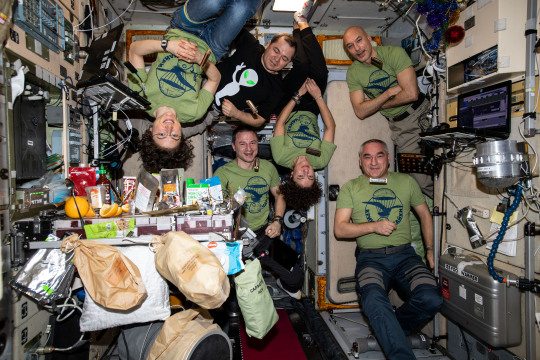
ISS Expedition 61 crew in the Zvezda service module for a New Year's Eve meal on 31 Dec 2019. Clockwise from top left: Christina Koch (NASA), Oleg Skripochka (Roscosmos), Luca Parmitano (European Space Agency), Alexander Skvortsov (Roscosmos), Jessica Meir (NASA), Andrew Morgan (NASA). [5568 x 3712] via /r/spaceporn https://ift.tt/2Fiyk4F
0 notes
Photo
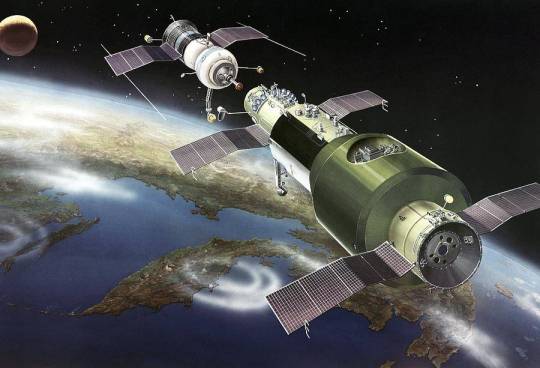
On April 19, 1971, the Soviet Union placed into orbit Salyut, the world’s first space station. Designed for a 6-month on orbit operational lifetime, Salyut hosted the crew of Georgi T. Dobrovolski, Vladislav N. Volkov, and Viktor I. Patsayev for a then record-setting 24-day mission. The flight ended tragically when the crew died due to the sudden depressurization of their Soyuz 11 spacecraft shortly before reentry into the Earth’s atmosphere. Over the succeeding decades, Soviet, and later Russian, engineers continually improved on the original Salyut design, launching ever more capable generations of space stations in the Salyut series and the Mir station’s Base Block. The Zvezda Service Module of the International Space Station’s Russian segment traces its heritage back to the world’s first space station of 50 years ago.
34 notes
·
View notes
Text
UFO Sighting Definitely Identified
The UFOs going past the ISS don't always have to be UFOs just like this awesome example. Still carrying out the research means that there is always scope for new information and that the people who are researching the ISS UFOs can accept any answer even if it's not a UFO answer.
#iss ufo#ufosightingsfootage#ufosfootage#ufo#ufos#realufo#ufonews#aliens#alien#moon#ufostoday#space station ufo
2 notes
·
View notes
Photo
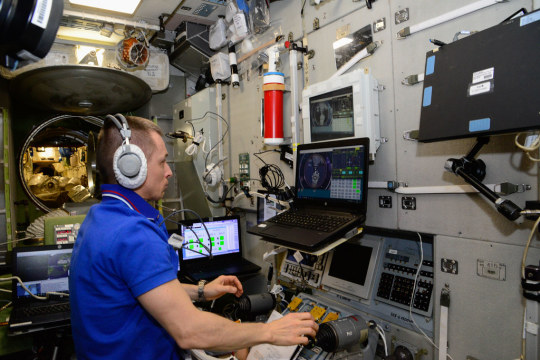
Expedition 64 Commander Sergey Ryzhikov works inside the Zvezda service module by NASA Johnson https://flic.kr/p/2kMk7wQ
17 notes
·
View notes
Link
The Progress 84 cargo craft is pictured shortly after undocking from the International Space Station’s Poisk Module at 2:55 a.m. EST.NASA NASA will provide live coverage of the launch and docking of a Roscosmos cargo spacecraft carrying about three tons of food, fuel, and supplies for the crew aboard the International Space Station. The unpiloted Progress 87 resupply spacecraft is scheduled to launch at 10:25 p.m. EST Wednesday, Feb. 14 (8:25 a.m. Baikonur time Thursday, Feb. 15), on a Soyuz rocket from the Baikonur Cosmodrome in Kazakhstan. Live coverage will begin at 10 p.m. on NASA+, NASA Television, the NASA app, YouTube, and the agency’s website. Learn how to stream NASA TV through a variety of platforms including social media. The Progress spacecraft will be placed into an orbit for a two-day journey to the space station, culminating in an automatic docking to the aft port of the Zvezda service module at 1:12 a.m. Saturday, Feb. 17. NASA coverage of rendezvous and docking will begin at 12:30 a.m. The International Space Station is a convergence of science, technology, and human innovation that enables research not possible on Earth. For more than 23 years, NASA has supported a continuous U.S. human presence aboard the orbiting laboratory, through which astronauts have learned to live and work in space for extended periods of time. The space station is a springboard for the development of a low Earth orbit economy and NASA’s next great leaps in exploration, including missions to the Moon under Artemis and ultimately, human exploration of Mars. Learn more about the space station, its research, and crew, at: https://www.nasa.gov/station -end- Josh Finch / Claire O’SheaHeadquarters, [email protected] / claire.a.o’[email protected] Sandra JonesJohnson Space Center, [email protected] Share Details Last Updated Feb 12, 2024 LocationNASA Headquarters Related TermsMissionsInternational Space Station (ISS)
0 notes